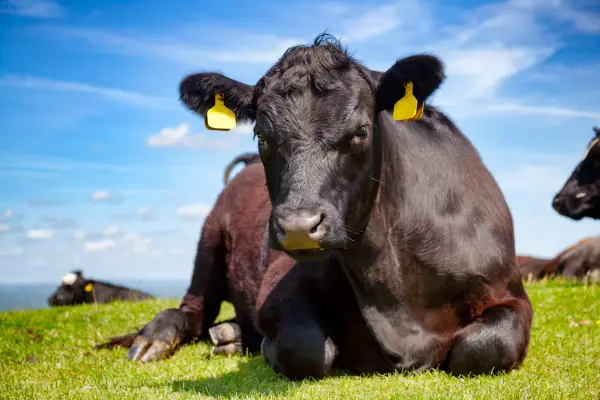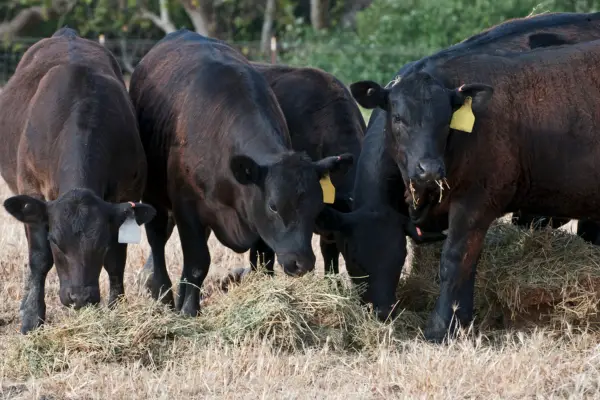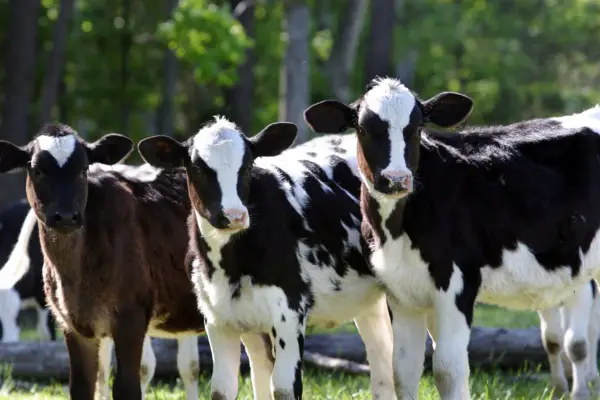Body Condition Scoring of Beef Cows
Good body condition scoring (BCS) is essential for beef herd management, enabling cattlemen to optimize cow health, fertility, calf growth, and ultimately profitability.
In this blog article, unveils the power of body condition scoring, demystifying the process while highlighting reproductive, health, and economic advantages.
Strategies for spring and fall calving herds are covered alongside tools for implementation and ethical considerations, providing a holistic blueprint for sustainable beef production. Read on to transform your herd management through this simple yet invaluable practice.
Why Body Condition Scoring Matters for Your Beef Herd?
Quite simply, BCS is a scoring system that evaluates the amount of fat and muscle a beef cow carries. Unlike weight tapes or scales, BCS provides a snapshot of stored energy reserves available to support key biological processes like lactation, growth, pregnancy and rebreeding.
Just as ranchers manage financial accounts to quantify assets and capital, BCS allows cattle producers to measure the ‘bottom line’ of cow energy reserves.
Tracking BCS identifies deficiencies before they escalate into herd-wide issues. Suboptimal BCS leads to delayed estrus, prolonged calving intervals, lighter calf weaning weights, and increased cull rates.
Monitoring body condition enables timely nutrition adjustments to safeguard cow health and productivity. As the adage goes: “What gets measured, gets managed.”
The Impact on Cow Health, Productivity, and Profitability
BCS influences both the quantity and quality of beef production. Proper body condition supports optimal pregnancy rates, milk production, calf growth, and cow longevity.
Monitoring body condition reveals opportunities to fine-tune nutrition, herd health programs, and management strategies for increased productivity.
While BCS curbs tangible losses like diminished weaning weights or open cows, its advantages extend far beyond the bottom line. Body condition scoring fosters responsible animal husbandry, upholding beef cattle welfare through proactive condition monitoring.
By aligning production practices with cow biology, optimal BCS systems enhance sustainability, propagating generations of healthy, thriving cattle.

1. Demystifying the BCS System:
Body condition scoring seems beguilingly simple at first glance. However, accurately assessing and applying this valuable index requires an intimate understanding of its framework along with proper scoring techniques. Let’s lift the veil on the fundamentals of body condition scoring.
A Simple Yet Effective Scale: Understanding the 1-to-9 Framework
The BCS scale spans nine points with 1 being extremely emaciated and 9 being extremely obese. This numeric system evaluates the relative fatness and muscling of beef cows by assessing visual indicators and palpable tissue reserves.
While seemingly straightforward, precision is critical as one-half to full-point differences impact production. Coarse measurements lead to delayed or misguided interventions, whereas diligent scoring enables tailored nutritional and management strategies for optimal results.
Visual and Palpation Techniques: Mastering the Art of Assessment
Accurately assigning BCS requires both ocular evaluation and hands-on palpation. Assessors must visually appraise cattle condition, noting fat deposition and muscling throughout the body. Particular focus is placed on bony prominence relief, rib visibility, and rump contour.
Equally important is manual palpation of key reference points like spinous processes, transverse processes, and tail heads. By simultaneously looking and feeling, accurate scores are systematically assigned.
This comprehensive approach is quick yet more informative than isolated metrics like body weight. Just 15 seconds per cow generates actionable data to direct management.
Addressing the Challenges: Accounting for Gut Fill and Pregnancy
When evaluating beef cows, distended abdomens hide true body reserves, confounding visual appraisal and palpation. Fortunately, assessment protocols account for these confounders.
For gut fill, evaluations are best performed before morning feeding or several hours afterwards when digesta has cleared the rumen and intestines. This ensures scores reflect actual fat and muscle rather than recent meals.
Pregnancy poses an additional challenge, progressively obscuring abdominal features essential for proper BCS evaluation. Focusing assessments on the loin, ribs, and tail head helps assessors derive accurate scores despite advanced pregnancy. Considering these factors removes potential ambiguity, enabling reliable scoring.

2. Beyond the Score
On the surface, BCS provides a snapshot of cow energy reserves. But this outward score reflects deeper health and productivity parameters necessary for optimal herd performance. What other insights can we glean from this invaluable index?
Limitations of BCS: Recognizing the Bigger Picture
Despite its utility for gauging energy reserves, BCS has its limitations. Most notably, high BCS alone fails to guarantee high conception rates or weaning weights.
Myriad other variables like genetics, disease, trace mineral balance, estrus expression, semen quality, and more affect cattle productivity.
Rather than an all-encompassing predictor of performance, BCS serves as a red flag signaling suboptimal conditions. Declining average herd BCS warrants further diagnostics into causative factors. Though not a silver bullet, this index channels investigations and interventions to bolster productivity.
Complementary Tools: Blood Tests, Mineral Panels, and More
To further illuminate factors impacting BCS, producers can employ blood testing. Monitoring metabolic indicators like glucose, insulin, thyroid hormones, and IGF-1 pinpoints nutritional deficiencies compromising cow productivity. Similarly, mineral panels identify imbalances hindering optimal body condition.
These lab tests form the basis of nutritional supplements and programming tailored to herd needs. BCS provides the impetus to pursue these diagnostics, while blood analytics determine specific formulations and feeding approaches to resolve deficiencies. This multi-pronged approach optimizes efficiency by revealing nuances affecting body condition.
Holistic Approach: Integrating BCS with Overall Cow Nutrition and Management
While a useful assessment metric, BCS alone provides limited utility without application towards nutrition and management strategies.
Comprehensively tracking body condition status, forage analyses, supplementation regimens, animal handling facilities, weather patterns, and prices of energy feed sources paints a complete picture of cattle programming needs and constraints.
Integrating BCS patterns with this broader context reveals opportunities for tactical improvements. Perhaps fields require reseeding to improve forage quality, minerals could be better formulated for soil conditions, or feed rations warrant adjustments to match cow requirements. Whatever the need, BCS rings the alarm to investigate and intervene accordingly.

3. Maximizing Reproductive Success through BCS:
Optimizing beef herd fertility hinges on proper body condition scoring strategies. From estrous cycle regulation to calving intervals, BCS profoundly impacts reproductive efficiency. Let’s examine how this simple scoring system begets sizable rewards in cow-calf productivity.
Calving Interval: The Key to Profitability and BCS’s Crucial Role
A beef cow must deliver a calf annually to remain profitable. This 365-day calving interval represents the pinnacle of production efficiency. BCS is inexorably tied to this timeline, with suboptimal levels driving delayed estrus and conception failure.
Cows calving in BCS 4 or lower experience significantly reduced pregnancy rates compared to ideal BCS 5 cows. This equates to prolonged days open and decreased lifetime productivity. Tracking body condition provides lead time to correct deficiencies through supplementation before conception or breeding periods.
Pre-Calving Body Condition: Setting the Stage for Optimal Performance
Calving commences a physiologically taxing sequence as cows simultaneously lactate and attempt to rebreed on limited forage quality. Insufficient body reserves during late gestation translate to weakened calving vigor, delayed estrus, and hindered conception rates post-calving.
Alternatively, cows entering the calving season at BCS 5-6 birth vigorous calves while readily transitioning into peak lactation.
These robust cows readily return to estrus shortly after calving, achieving superior conception rates on time for the next calving deadline. Once again, strategic BCS monitoring and modulation sets the trajectory for optimal reproductive success.
Balancing Breeding Season Nutrition with Maintaining Good BCS
Breeding season necessitates optimal body condition for heightened fertility, but demands can outpace nutritional intake. Cows being bred while nursing calves have elevated needs met by mobilizing body tissues despite quality grazing.
Supplemental feeding through breeding boosts body condition, curbing excessive mobilization while supporting lactation and return to estrus.
This taxing phase maintains body condition by providing balanced, digestible energy sources like cereal grains or complete feeds. With strategic supplementation, successful rebreeding prevents long-term BCS losses.

4. Spring-Calving vs. Fall-Calving: Tailoring BCS Strategies
Beef producers utilize two primary calving seasons: spring and fall. The challenges of BCS management differ considerably between these systems based on weather patterns, forage availability, and cattle needs through the yearly production cycle. Strategies must be tailored accordingly.
Springtime Harmony: Synchronizing Forage Quality and Cow Needs
Spring calving herds enjoy prime grazing through late gestation with calves born as pastures transition to high nutritional value.
Lactation demands correspond to peak pasture quality, while cows rebreed on an abundance of high-quality forage. This synchrony makes maintaining proper BCS relatively straightforward.
However, BCS should still be monitored through the winter feeding period. Inclement weather may mandate cow supplementation to maintain body reserves. Overall though, spring-calving programming aligns cow requirements with seasonal forage quality.
Winter Challenges: Managing BCS in Fall-Calving Herds
In contrast, fall-calving demands clash with environmental constraints. Cow energy requirements peak through late gestation and early lactation amid limited pasture availability and quality. Without strategic supplementation, body condition plummets setting up reproductive failure.
Meticulous BCS tracking enables beef producers to identify deficient cows for specialized feeding. Custom mineral and protein formulations offset poor forage quality, supporting proper condition entering calving. Despite logistical challenges, successful fall calving hinges on diligent BCS monitoring through winter.
Weaning: A Strategic Opportunity to Rebuild Condition
Weaning splits the tight link between lactation and rebreeding, providing a window to restore depleted body reserves. Cows experience tremendous metabolic relief upon calf separation, halting energy drains from milk production.
Capitalizing on this respite, producers can improve body condition prior to breeding through high-quality pastures or balanced supplementation. Bolstering reserves post-weaning rectifies marginal body conditions, driving fertility and subsequent production gains.

5. Economic Advantages: Quantifying the Value of Good BCS
Beyond qualitative benefits like cow welfare and calf vigor, optimal BCS management yields tangible financial rewards. Shortened calving intervals, heavier weaning weights, and longevity directly enhance ranch profitability.
Calving Interval Impact: Dollars and Cents of Shorter Gestation Periods
As established, calving intervals exceeding 365 days erode efficiency by diminishing lifetime calves weaned. Translated into monetary terms, just one extra day open past the 82-83 day rebreeding timeline costs over $3 per cow based on lost future production.
Compounding this across an entire herd reveals how proper BCS and prompt rebreeding rapidly escalate revenues. Achieving year-round calving through optimal body condition management directly improves annual income margins.
Heavier Calves, Higher Profits: The Financial Recompense of Optimal BCS
In addition to accelerated rebreeding, adequate body reserves beget faster-growing calves. Cows calving in better condition birth more vigorous calves that excel in milk harvesting abilities with enhanced growth rates.
Studies estimate that each increment of 200 pounds weaning weight equals nearly $40 more profit per calf based on livestock market trends. Multiplied by an entire calf crop, an extra 30 to 60 pounds of weaning weight per calf from quality BCS management generates major financial returns.
Beyond Numbers: Sustainable Herd Management and Long-Term Gains
Quite simply, diligent BCS tactics lead to healthier, heavier calves that return greater revenues through sales. Yet the advantages run deeper still. Strategic nutrition and body condition management bolster cow longevity, reducing annual cull rates due to reproductive failure or illness.
Cull rates exceeding 10% slash herd profitability by necessitating expensive replacements sourced externally. Optimized breeding success through BCS monitoring retains robust, fertile females for asset sustainability.
While economic calculators showcase direct calf performance gains, the long-term herd stability imparted by attentive BCS management future-proofs operations for reliable returns.

6. Balancing Economics and Ethics: Navigating the Challenges
Implementing an intensive BCS program predicated solely on financial KPIs loses sight of cattlemen’s reciprocal relationship with our herds. We must balance driving productivity with upholding cow integrity through responsible, ethical practices.
Responsible BCS Strategies: Ensuring Cow Welfare while Optimizing Production
Beef producers should align condition scoring protocols with innate cattle biology rather than forcing unnaturally elevated BCS and productivity benchmarks. Example science-based targets reflecting cattle’s natural calving seasonality include:
- BCS 4 minimum pre-calving
- BCS 5-6 entering breeding season
- BCS 4-5 for mature cows by weaning
Customizing goals based on cattle type, terrain, and climate while allowing marginal flexibility safeguards cow welfare even during stochastically tough years. Periodic body condition assessment followed by appropriate interventions keeps herds thriving.
Environmental Considerations: Minimizing the Footprint of Body Condition Management
Nutrition programs supporting BCS must utilize responsible sourcing and stewardship practices to uphold land integrity. Whether grazing cattle on well-managed pastures or sourcing supplemental feeds, environmentally-conscious decisions make programs more sustainable.
For instance, relying on rotating complimentary forage species naturally enriches soil fertility to boost future grass quality. Similarly, locally sourcing supplement crops via regenerative farming practices or waste stream reclamation circumvents deforestation linked to mass commodity crop production.
Keeping environmental considerations at the forethought of BCS-focused nutrition helps balance optimal beef production with ecological stability.
Building a Sustainable Future: Balancing Profitability with Ethical Practices

In the end, cattle producers focused purely on rapid financial growth inevitably face future consequences from overtaxed herds and land. Rather, robust yet ethical BCS tactics that align with cattle health and the environment deliver lasting returns.
Modelling such conscientiousness through proactive BCS assessments fosters healthier cattle and pastures for generations to come. Our herds, harvested calves, and the lands they graze can all thrive in synchronization through balanced BCS management.
Consulting with Experts: Seeking Professional Guidance for Tailored Strategies
While smartphone apps and online references provide general guidelines, nothing replaces expert consultation. Animal health professionals like livestock nutritionists, reproductive specialists, and veterinary clinicians offer personalized guidance.
These experts objectively audit body condition data in the context of broader herd analytics. Through this holistic lens, tailored counselling targets underlying issues provides customized solutions like advanced feed ration balancing and outlines executable protocols to optimize BCS efficiency on every operation.
Conclusion:
The hallmark of proficient cattlemen is proactively managing what matters most – cow health and the resulting productivity. Body condition scoring represents an invaluable yet underutilized tool to achieve such outcomes in beef herd management.
By distilling complex nutritional adequacy and body reserves into an easily captured score, this system furnishes critical data to direct interventions that optimize cow performance.
Optimizing Health, Productivity, and Profitability
When woven into overarching herd analytics and decision matrices, diligent body condition scoring unlocks the potential for properly conditioned cows, thriving calves, and ultimately more profitable beef production. This simple scoring system becomes a powerful instrument to promote animal wellbeing alongside superior weight gains that translate into financial success.
Proactive Management for Sustainable Success
Beyond realizing such outcomes, the overarching benefit of body condition scoring is empowerment. As seasons, genetics, markets, and environments perpetually change, a proactive stance is essential to sustain profitability. Body condition scoring shifts beef producers from passive observers to engaged directors of their herds’ welfare and productivity.
Much like routinely assessing financial statements or planting schedules, body condition scoring boosts capabilities to make management adjustments to keep herds and profits growing.
By assessing cow condition at critical junctures, producers open windows to nutritional, health, and husbandry interventions that set herds up for success – all through a simple, rapid scoring system.
Just as savvy accountants monitor assets to guide investment decisions, cattle producers can manage the most valuable asset – their herds – to growth and profitability through diligent body condition scoring protocols.


